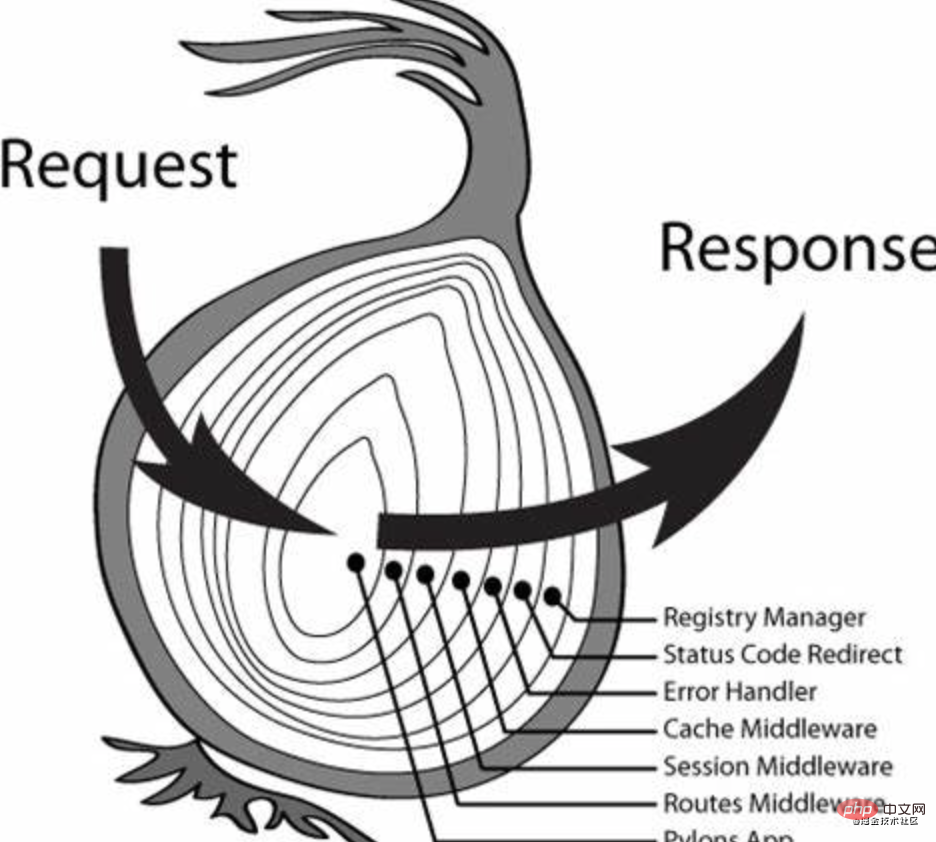 Web Front-end
Web Front-end
 JS Tutorial
JS Tutorial
 Understand the principles of JavaScript's node middleware in simple terms
Understand the principles of JavaScript's node middleware in simple terms
Understand the principles of JavaScript's node middleware in simple terms
Todayjavascript column introduces the principle of node middleware.

Related free learning recommendations: javascript(Video)
Preface
Middleware is a type of software between application systems and system software. It uses the basic services (functions) provided by system software to connect the network Each part of the application system or different applications can achieve the purpose of resource sharing and function sharing.
In NodeJS, Middleware mainly refers to the method of encapsulating http request details processing. We all know that many actions are often involved in http requests, as follows:
- IP filtering
- Query string delivery
- Request body Parsing
- Cookie information processing
- Permission verification
- Logging
- Session management middleware (session)
- gzip compression middleware (Such as compress)
- Error handling
Of course there are many custom processing actions. For Web applications, we don’t want to know every one Instead of detailed processing work, we hope to focus on business development in order to improve development efficiency, so Node middleware is introduced to simplify and encapsulate these basic logic processing details.
node middlewareEssentially, it allows specific filters to process before entering specific business processing. As shown in the figure below: 
The mainstream nodejs frameworks we currently see, such as connect, koa, express, egg, nest, etc. are all inseparable from the design concept of middleware, so in order to allow everyone to have a deeper peek into the nodejs world, we have comparatively studied the implementation principles of middleware.
Text
After understanding the concept of node middleware, we will manually implement the middleware. Finally, we will briefly analyze the implementation ideas of middleware in koa. The outline of the article is as follows:
- Node middleware core principle implementation
- koa middle key implementation method
- Use the koa middleware mechanism to implement your own koa middleware
node middleware core principle implementation
From the above introduction, we can see that middleware is the processing logic from the beginning of the http request to the end of the response. It usually needs to process the request and response. We are implementing the node middleware mode Another issue that needs to be considered is the coexistence of multiple middleware. We need to think about how to automate the execution of multiple middleware. Otherwise, only the first middleware will be executed in the process from request to response, so our basic middleware The file format is as follows:
const middleware = (req, res, next) => { // 请求处理逻辑
next()
}复制代码Next, let’s write a simple case to see how the middleware is implemented.
// 定义几个中间间函数const m1 = (req, res, next) => { console.log('m1 run')
next()
}const m2 = (req, res, next) => { console.log('m2 run')
next()
}const m3 = (req, res, next) => { console.log('m3 run')
next()
}// 中间件集合const middlewares = [m1, m2, m3]function useApp (req, res) { const next = () => { // 获取第一个中间件
const middleware = middlewares.shift() if (middleware) {
middleware(req, res, next)
}
}
next()
}// 第一次请求流进入useApp()复制代码It is not difficult for us to find out from the above codenext# The role of ## is to realize the key parameters of automatically calling the middleware chain. The print result is as follows:
m1 run m2 run m3 run复制代码
const m2 = (req, res, next) => {
fetch('/xxxxx').then(res => {
next()
})
}复制代码next When the function performs secondary processing, we can wrap the return value of next into promise, so that it can continue to process the middleware logic through the then callback after the business processing is completed. As shown below:
function useApp (req, res) { const next = () => { const middleware = middlewares.shift() if (middleware) { // 将返回值包装为Promise对象
return Promise.resolve(middleware(req, res, next))
}else { return Promise.resolve("end")
}
}
next()
}复制代码const m1 = (req, res, next) => { console.log('m1 start') return next().then(() => { console.log('m1 end')
})
}复制代码const m1 = async (req, res, next) => { // something...
let result = await next();
}
const m2 = async (req, res, next) => { // something...
let result = await next();
} const m3 = async (req, res, next) => { // something...
let result = await next(); return result;
}const middlewares = [m1, m2, m3];function useApp (req, res) { const next = () => { const middleware = middlewares.shift() if (middleware) { return Promise.resolve(middleware(req, res, next))
}else { return Promise.resolve("end")
}
}
next()
}// 启动中间件useApp()复制代码
function compose (middleware) { // 提前判断中间件类型,防止后续错误
if (!Array.isArray(middleware)) throw new TypeError('Middleware stack must be an array!') for (const fn of middleware) { // 中间件必须为函数类型
if (typeof fn !== 'function') throw new TypeError('Middleware must be composed of functions!')
} return function (context, next) { // 采用闭包将索引缓存,来实现调用计数
let index = -1
return dispatch(0) function dispatch (i) { // 防止next()方法重复调用
if (i <= index) return Promise.reject(new Error('next() called multiple times'))
index = i let fn = middleware[i] if (i === middleware.length) fn = next if (!fn) return Promise.resolve() try { // 包装next()返回值为Promise对象
return Promise.resolve(fn(context, dispatch.bind(null, i + 1)));
} catch (err) { // 异常处理
return Promise.reject(err)
}
}
}
}复制代码利用koa中间件机制实现一个自己的koa中间件
学习了中间件的设计机制和原理, 我们是不是想马上写一个中间件呢? 笔者这里给大家举一个例子. 在H5-Dooring项目的服务端代码中, 我们需要对用户登录权限进行分发, 此时我们提供统一个中间件来处理, 如下代码所示:
// 模拟数据库操作const token = db.user();// router或者koa的中间件一定要用await处理next,否则将不能正常响应数据export default async (ctx, next) => { const t = ctx.request.header.authorization let uid = ctx.request.header['x-requested-with'] let uidArr = uid.split(',') if(uidArr.length > 1) {
uid = uidArr.pop().trim()
} if(token[uid] && token[uid][1] === t) { await next()
}else {
ctx.status = 403;
ctx.body = { state: 403, msg: '你没有权限操作'
}
}
}复制代码以上代码即实现用户登录态处理, 如果用户在没有登录的情况下防问任何需要登录的接口, 都将返回权限不足或则在请求库中让其重定向到登录页面.
所以, 今天你又博学了吗?
The above is the detailed content of Understand the principles of JavaScript's node middleware in simple terms. For more information, please follow other related articles on the PHP Chinese website!

Hot AI Tools

Undresser.AI Undress
AI-powered app for creating realistic nude photos

AI Clothes Remover
Online AI tool for removing clothes from photos.

Undress AI Tool
Undress images for free

Clothoff.io
AI clothes remover

AI Hentai Generator
Generate AI Hentai for free.

Hot Article

Hot Tools

Notepad++7.3.1
Easy-to-use and free code editor

SublimeText3 Chinese version
Chinese version, very easy to use

Zend Studio 13.0.1
Powerful PHP integrated development environment

Dreamweaver CS6
Visual web development tools

SublimeText3 Mac version
God-level code editing software (SublimeText3)

Hot Topics
 1378
1378
 52
52
 How to implement an online speech recognition system using WebSocket and JavaScript
Dec 17, 2023 pm 02:54 PM
How to implement an online speech recognition system using WebSocket and JavaScript
Dec 17, 2023 pm 02:54 PM
How to use WebSocket and JavaScript to implement an online speech recognition system Introduction: With the continuous development of technology, speech recognition technology has become an important part of the field of artificial intelligence. The online speech recognition system based on WebSocket and JavaScript has the characteristics of low latency, real-time and cross-platform, and has become a widely used solution. This article will introduce how to use WebSocket and JavaScript to implement an online speech recognition system.
 WebSocket and JavaScript: key technologies for implementing real-time monitoring systems
Dec 17, 2023 pm 05:30 PM
WebSocket and JavaScript: key technologies for implementing real-time monitoring systems
Dec 17, 2023 pm 05:30 PM
WebSocket and JavaScript: Key technologies for realizing real-time monitoring systems Introduction: With the rapid development of Internet technology, real-time monitoring systems have been widely used in various fields. One of the key technologies to achieve real-time monitoring is the combination of WebSocket and JavaScript. This article will introduce the application of WebSocket and JavaScript in real-time monitoring systems, give code examples, and explain their implementation principles in detail. 1. WebSocket technology
 How to use JavaScript and WebSocket to implement a real-time online ordering system
Dec 17, 2023 pm 12:09 PM
How to use JavaScript and WebSocket to implement a real-time online ordering system
Dec 17, 2023 pm 12:09 PM
Introduction to how to use JavaScript and WebSocket to implement a real-time online ordering system: With the popularity of the Internet and the advancement of technology, more and more restaurants have begun to provide online ordering services. In order to implement a real-time online ordering system, we can use JavaScript and WebSocket technology. WebSocket is a full-duplex communication protocol based on the TCP protocol, which can realize real-time two-way communication between the client and the server. In the real-time online ordering system, when the user selects dishes and places an order
 How to implement an online reservation system using WebSocket and JavaScript
Dec 17, 2023 am 09:39 AM
How to implement an online reservation system using WebSocket and JavaScript
Dec 17, 2023 am 09:39 AM
How to use WebSocket and JavaScript to implement an online reservation system. In today's digital era, more and more businesses and services need to provide online reservation functions. It is crucial to implement an efficient and real-time online reservation system. This article will introduce how to use WebSocket and JavaScript to implement an online reservation system, and provide specific code examples. 1. What is WebSocket? WebSocket is a full-duplex method on a single TCP connection.
 Pi Node Teaching: What is a Pi Node? How to install and set up Pi Node?
Mar 05, 2025 pm 05:57 PM
Pi Node Teaching: What is a Pi Node? How to install and set up Pi Node?
Mar 05, 2025 pm 05:57 PM
Detailed explanation and installation guide for PiNetwork nodes This article will introduce the PiNetwork ecosystem in detail - Pi nodes, a key role in the PiNetwork ecosystem, and provide complete steps for installation and configuration. After the launch of the PiNetwork blockchain test network, Pi nodes have become an important part of many pioneers actively participating in the testing, preparing for the upcoming main network release. If you don’t know PiNetwork yet, please refer to what is Picoin? What is the price for listing? Pi usage, mining and security analysis. What is PiNetwork? The PiNetwork project started in 2019 and owns its exclusive cryptocurrency Pi Coin. The project aims to create a one that everyone can participate
 JavaScript and WebSocket: Building an efficient real-time weather forecasting system
Dec 17, 2023 pm 05:13 PM
JavaScript and WebSocket: Building an efficient real-time weather forecasting system
Dec 17, 2023 pm 05:13 PM
JavaScript and WebSocket: Building an efficient real-time weather forecast system Introduction: Today, the accuracy of weather forecasts is of great significance to daily life and decision-making. As technology develops, we can provide more accurate and reliable weather forecasts by obtaining weather data in real time. In this article, we will learn how to use JavaScript and WebSocket technology to build an efficient real-time weather forecast system. This article will demonstrate the implementation process through specific code examples. We
 Simple JavaScript Tutorial: How to Get HTTP Status Code
Jan 05, 2024 pm 06:08 PM
Simple JavaScript Tutorial: How to Get HTTP Status Code
Jan 05, 2024 pm 06:08 PM
JavaScript tutorial: How to get HTTP status code, specific code examples are required. Preface: In web development, data interaction with the server is often involved. When communicating with the server, we often need to obtain the returned HTTP status code to determine whether the operation is successful, and perform corresponding processing based on different status codes. This article will teach you how to use JavaScript to obtain HTTP status codes and provide some practical code examples. Using XMLHttpRequest
 How to use insertBefore in javascript
Nov 24, 2023 am 11:56 AM
How to use insertBefore in javascript
Nov 24, 2023 am 11:56 AM
Usage: In JavaScript, the insertBefore() method is used to insert a new node in the DOM tree. This method requires two parameters: the new node to be inserted and the reference node (that is, the node where the new node will be inserted).



